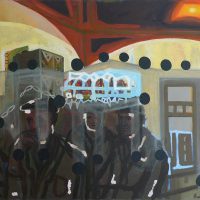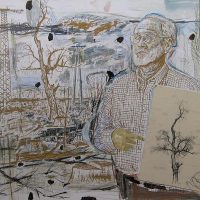In The Pub, oil on canvas, 2009
Self portrait. etching, watercolour. pastel, indian ink on paper and on wood panel, 2012
From the beginning, he has selected his subjects from the objects, scenes and figures of a life of hard work, to represent which he employs the most diverse devices: he turns his paintings into assemblages by incorporating natural materials of all description (hair, wood, maize, tiles, matches, etc.). In objects, installations and performances he links the everyday articles of peasant object culture as a matter of course, or uses them to build unique mechanical-visual constructions.
His portraits and compositions can be considered special studies in sociology, though Bukta’s perspective is not that of the disinterested and distant analyst: he looks at, and represents, this peculiar world, full of bittersweet overtones, from the inside. Whether his approach is ironic, melancholic, (socially) critical or conceding, he always treats his subjects with an uncommon empathy.
After 1998 when Imre Bukta moved back to his native village Mezőszemere his interest gradually turned to paintings. These paintings can be ever more easily classified under such classic generic headings as genres, interiors, portraits and landscapes. His signature filler motifs (stippling, fluting, mesh patterns, etc.) are more and more decorative, and assume a life of their own, independently of the composition.
In the year 2011 he presented his large-sized, paper-based pictures which bring a synthesis of the “striping” fields applied in the 80’s and the finer elaborated artworks of the 90’s. The pieces of this series represent pastel colours instead of the heavy oils, but Bukta practises so much techniques – ink, graphite, tempera, watercolor, carbon – that they look like collage remotely and evoke the applications used by the artist before.
With these artworks he develops the landscape he has been presented with consequent loyalty and consistency, besides he offers escape to the spectators; he could namely create in this drear land a workshop, an atmosphere, a family, a group of friends in which anybody could feel at home.

